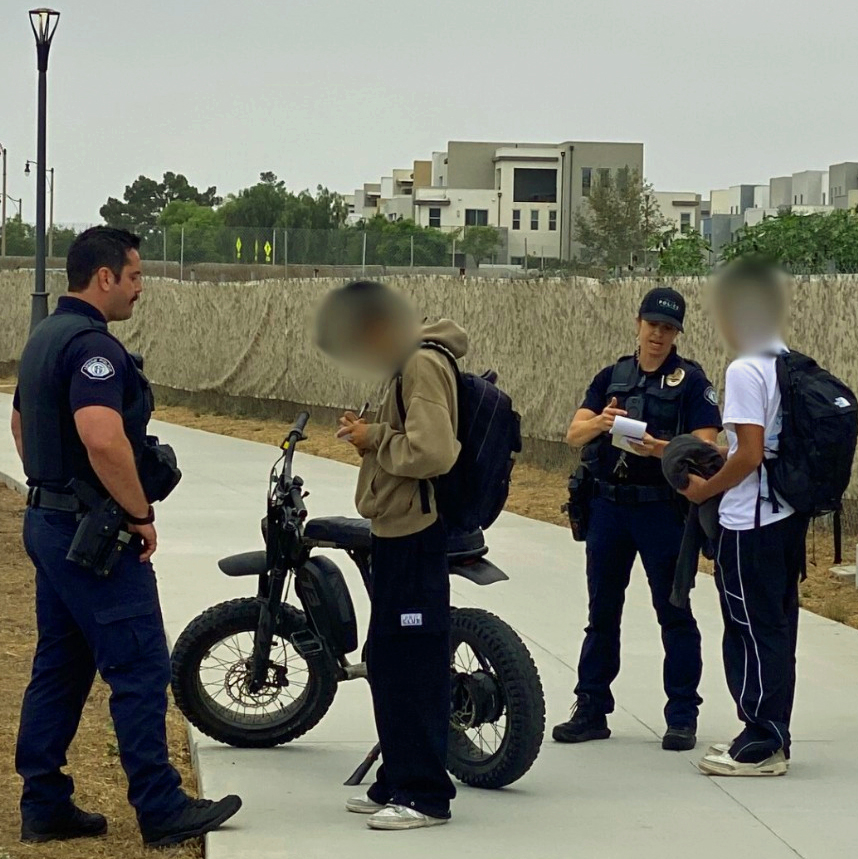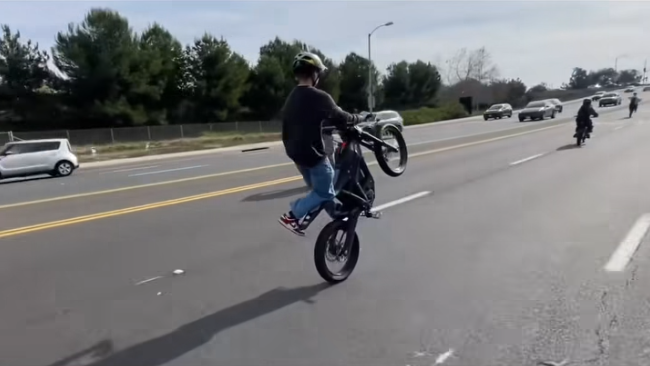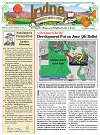
Irvine police officers citing two students for riding an e-bike, illegally, without helmets
Biking offers kids fun, freedom, and great exercise. But the standard bikes we grew up with are now being replaced by electric bikes (e-bikes).
A growing number of Irvine students are using e-bikes to get to and from school, and for getting around town. Physicians, police officers, and emergency medical service professionals have begun raising safety concerns due to the increase and severity of e-bike collisions and injuries.
Local trauma surgeons are dealing with unprecedented injuries among children involved in e-bike collisions. Kids are being treated for multiple e-bike crashes — resulting in leg fractures and traumatic brain injuries that require hospital admissions, intensive care, surgeries, and ongoing treatment. We’ve also seen students lose control of their e-bikes and crash into parked or moving cars. Many of these kids were not wearing helmets that protect the brain and face, which has led to major facial injuries that can require extensive reconstructive surgery to correct.
We are especially alarmed by the lack of helmet use among students riding e-bikes in Irvine. All bicyclists (and e-bike riders) under the age of 18 are required by California law to wear helmets. Required helmets have been proven to significantly reduce the risk of traumatic brain injuries that may result in serious acute and chronic cognitive and learning disabilities. We believe that everyone riding an e-bike — regardless of age or skill level — should be wearing a helmet. Conventional bike helmets may be appropriate at low speeds, but when traveling at higher speeds, moped helmets are more protective and recommended by the Consumer Product Safety Commission.
E-bikes may look like regular bicycles, but they are not. E-bikes are considerably heavier, faster, and harder to operate. That’s why we are seeing more severe injuries in children — similar to those seen among moped and motorcycle users. When an e-bike crash occurs, studies show that kids have a higher incidence of head trauma and experience more severe cases of neck injuries.
E-bike operators require a specific set of skills.
E-bike operators require a different set of skills compared to traditional bicyclists. Riding an e-bike calls for extra training. It is crucial parents understand the different e-bike classifications so that the appropriate bike is purchased for a child’s specific needs and skill level.
There are three classifications for e-bikes:
Class 1: The e-bike motor only works when the rider is pedaling. These bikes can reach speeds up to 20 mph.
Class 2: The e-bike includes a throttle that allows the rider to use the bike motor with or without pedaling. These bikes can also reach speeds up to 20 mph.
Class 3: The e-bike may or may not have a throttle but can reach speeds up to 28 mph or more.
NOTE: Based on developmental milestones of children, the Consumer Product Safety Commission recommends that children under the age of 12 should not operate any product that travels faster than 10 mph.
California has e-bike regulations.
California law currently requires all individuals under the age of 18 to wear a helmet for any bicycle (including all e-bike classifications). And adult riders of Class 3 e-bikes must also wear a helmet.
Young children should not be riding e-bikes.
E-bikes are being marketed for children as young as 4-8 years of age, which is extremely dangerous! Young children lack the motor and situational hazard awareness skills required to use motorized vehicles such as e-bikes. Children at these ages are just learning how to cross streets, gauge traffic, and understand road signage. Instead of e-bikes, parents should be teaching their young children how to safely ride a standard bicycle (with a properly fitted and secured helmet).

Photo captured from IPD video
There are also teen safety concerns.
Teens often exhibit reckless behavior because the adolescent brain is still developing executive function, impulse control, and other protective functions. Peer pressure, risk-taking behavior, and insufficient impulse control are risk factors for serious injury and even death. Parents must approach e-bike use with the same caution they use when their teens begin to drive cars. That means educating your kids on the rules of the road, explaining the importance of non-distracted operation, and making sure they attend safety classes and receive lessons from experts.
To make matters worse, too many teens are modifying their e-bikes to obtain higher speeds. All legal e-bikes are restricted to a maximum 750-watt motor. However, with easy access to the Internet it only takes a few minutes for kids to find out how to make changes to their e-bikes. Officers from the Irvine Police Department (IPD) have clocked Irvine students on modified e-bikes traveling more than 80 mph. Watch the shocking IPD video here.
Not only are students injuring themselves, their reckless driving puts pedestrians and automobiles at risk. The IPD has reported numerous incidents of teens driving through stop signs on major Irvine roadways.
We believe that we licensing systems should be implemented to ensure that teens don’t begin driving an e-bike until they have acquired the skills and knowledge required to keep them (and the community) safe.
Here’s how you can help:
- If you are at a store and see e-bikes being targeted to children under the age of 12, let the manager know that selling these products to young kids is simply unacceptable.
- Before purchasing an e-bike for your child, attend one of the free e-bike safety workshops offered by the IPD.
- Have an IPD officer inspect your child’s e-bike to ensure that it has not been altered for faster speeds than designed.
- Educate yourself on e-bike battery storage, fire hazards, and general maintenance. Consider a professional check-up of your child’s e-bike every year.
- Support local policies to make sure that the IPD has the resources required to enforce the laws requiring helmet use, to maintain speed and rider limits, and to continue the department’s e-bike safety courses.
- Make sure our City’s school resource officers are collaborating with the Irvine and Tustin Unified School Districts to educate and to enforce e-bike requirements on all school campuses.
- Use social media to inform others of the hazards of e-bike use.
Resource Links:
Irvine Police Department: E-Bike Safety
City of Irvine: Electric Bicycle Safety
American College of Surgeons Committee on Trauma: E-Bike Safety Statement
American Association of Neurological Surgeons: Statement on E-Bike Safety
Consumer Product Safety Commission: Helmet Use
American Academy of Pediatrics: Walking and Biking to School Safety Guidance
Orange County Transportation Authority E-Bike Information
Southern California American College of Surgeons: E-Bike Safety Tips
American College of Surgeons: E-Bike Safety Article
- E-Bike Crashes & Injuries on the Rise - November 8, 2025



